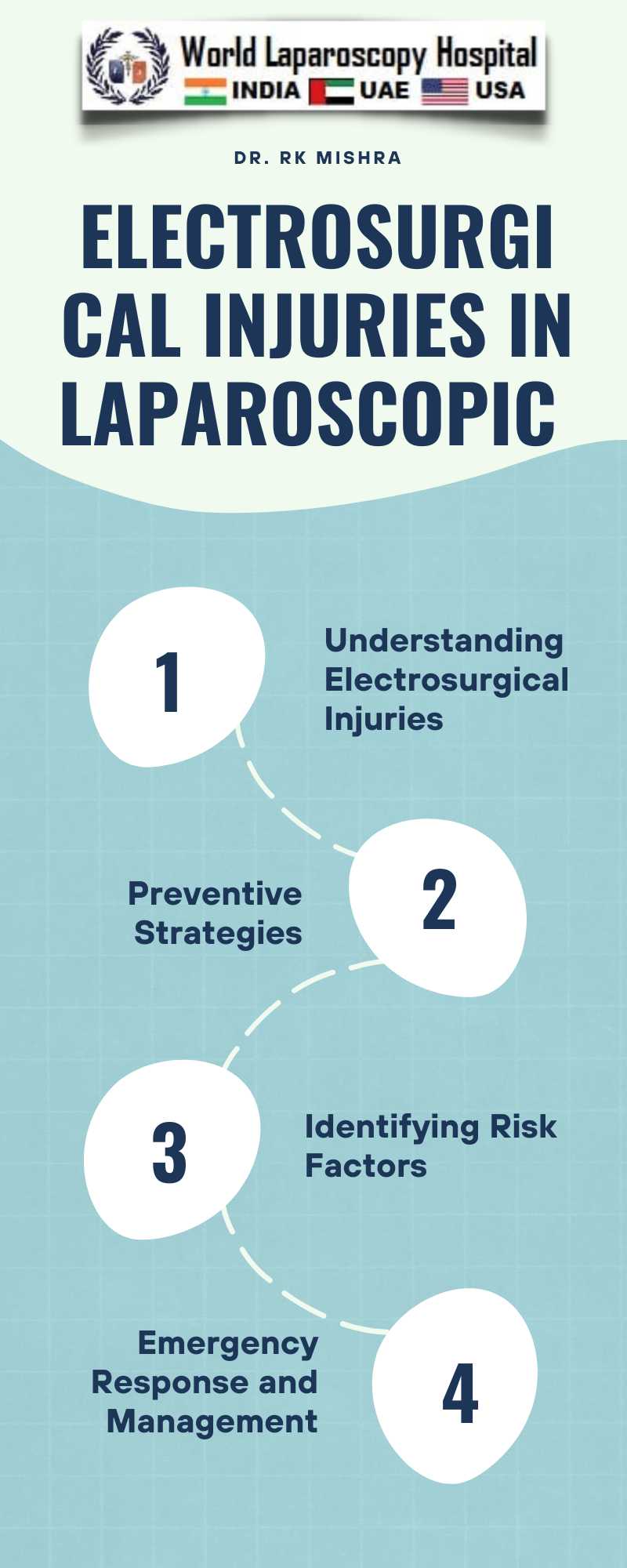Electrosurgical Injuries in Laparoscopic Surgery: Prevention and Response
Introduction
Laparoscopic surgery, a minimally invasive surgical technique, has revolutionized the field of surgery, offering benefits such as reduced pain, shorter hospital stays, and quicker recovery times. However, the use of electrosurgical instruments in these procedures introduces risks, primarily in the form of thermal injuries. Understanding these risks and implementing strategies for prevention and response is crucial for patient safety.

Electrosurgical Instruments in Laparoscopic Surgery
Electrosurgical instruments use high-frequency electrical currents to cut tissue and control bleeding. In laparoscopy, these instruments enable precision and efficiency. However, the confined space and limited visibility increase the risk of inadvertent thermal injuries to surrounding tissues and organs.
Types of Electrosurgical Injuries
1. Direct coupling: Occurs when active electrode comes in contact with non-target tissues.
2. Capacitive coupling: Happens when electrical current is unintentionally transferred from an instrument to adjacent conductive structures.
3. Insulation failure: Involves electrical current escaping from damaged insulation of the instrument.
4. Alternate site burns: Occur away from the surgery site, often at grounding pads.
Prevention Strategies
Prevention of electrosurgical injuries in laparoscopic surgery is multi-faceted:
1. Training and Education: Surgeons and operating room staff should be thoroughly trained in the use of electrosurgical instruments.
2. Equipment Checks: Regular inspection and maintenance of instruments to identify and repair any insulation failures.
3. Surgical Technique: Proper use of instruments, including awareness of potential capacitive coupling and careful placement of grounding pads.
4. Technological Advances: Utilization of newer technologies with safety features, such as active electrode monitoring systems.
Response to Electrosurgical Injuries
1. Immediate Identification: Quick recognition of an injury is vital for prompt response.
2. Assessment and Management: Assess the extent of the injury and manage it according to its severity, which may involve additional surgical repair.
3. Postoperative Care: Close monitoring for complications like infection or delayed perforation.
4. Documentation and Review: Detailed recording of the incident and review of the circumstances leading to the injury for future prevention.
Conclusion
Electrosurgical injuries in laparoscopic surgery, though relatively rare, have serious implications for patient safety. The adoption of comprehensive prevention strategies, continuous education and training, and a vigilant response protocol are essential for minimizing these risks. As technology advances, there is hope for more innovative solutions to further reduce the incidence of these injuries and enhance the overall safety of laparoscopic surgery. In conclusion, while laparoscopic surgery has brought many advantages to the field of surgery, the responsibility to recognize, prevent, and manage electrosurgical injuries remains a critical aspect of surgical practice. Continuous efforts in training, technology, and technique refinement are key to ensuring patient safety and successful surgical outcomes.
Laparoscopic surgery, a minimally invasive surgical technique, has revolutionized the field of surgery, offering benefits such as reduced pain, shorter hospital stays, and quicker recovery times. However, the use of electrosurgical instruments in these procedures introduces risks, primarily in the form of thermal injuries. Understanding these risks and implementing strategies for prevention and response is crucial for patient safety.

Electrosurgical Instruments in Laparoscopic Surgery
Electrosurgical instruments use high-frequency electrical currents to cut tissue and control bleeding. In laparoscopy, these instruments enable precision and efficiency. However, the confined space and limited visibility increase the risk of inadvertent thermal injuries to surrounding tissues and organs.
Types of Electrosurgical Injuries
1. Direct coupling: Occurs when active electrode comes in contact with non-target tissues.
2. Capacitive coupling: Happens when electrical current is unintentionally transferred from an instrument to adjacent conductive structures.
3. Insulation failure: Involves electrical current escaping from damaged insulation of the instrument.
4. Alternate site burns: Occur away from the surgery site, often at grounding pads.
Prevention Strategies
Prevention of electrosurgical injuries in laparoscopic surgery is multi-faceted:
1. Training and Education: Surgeons and operating room staff should be thoroughly trained in the use of electrosurgical instruments.
2. Equipment Checks: Regular inspection and maintenance of instruments to identify and repair any insulation failures.
3. Surgical Technique: Proper use of instruments, including awareness of potential capacitive coupling and careful placement of grounding pads.
4. Technological Advances: Utilization of newer technologies with safety features, such as active electrode monitoring systems.
Response to Electrosurgical Injuries
1. Immediate Identification: Quick recognition of an injury is vital for prompt response.
2. Assessment and Management: Assess the extent of the injury and manage it according to its severity, which may involve additional surgical repair.
3. Postoperative Care: Close monitoring for complications like infection or delayed perforation.
4. Documentation and Review: Detailed recording of the incident and review of the circumstances leading to the injury for future prevention.
Conclusion
Electrosurgical injuries in laparoscopic surgery, though relatively rare, have serious implications for patient safety. The adoption of comprehensive prevention strategies, continuous education and training, and a vigilant response protocol are essential for minimizing these risks. As technology advances, there is hope for more innovative solutions to further reduce the incidence of these injuries and enhance the overall safety of laparoscopic surgery. In conclusion, while laparoscopic surgery has brought many advantages to the field of surgery, the responsibility to recognize, prevent, and manage electrosurgical injuries remains a critical aspect of surgical practice. Continuous efforts in training, technology, and technique refinement are key to ensuring patient safety and successful surgical outcomes.
1 COMMENTS
Dr. Sairam S Iyer
#1
Jan 27th, 2024 10:21 am
Electrosurgical injuries in laparoscopic surgery, though rare, pose serious safety concerns. Comprehensive prevention, continuous education, and a vigilant response protocol are crucial. Advancing technology offers hope for innovative solutions to further reduce these risks, underscoring the ongoing responsibility in surgical practice for recognizing, preventing, and managing electrosurgical injuries. Continuous efforts in training, technology, and technique refinement are pivotal for ensuring patient safety and successful surgical outcomes.
| Older Post | Home | Newer Post |

